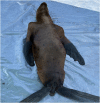Mass mortality event in South American sea lions (Otaria flavescens) correlated to highly pathogenic avian influenza (HPAI) H5N1 outbreak in Chile
- PMID: 37768676
- PMCID: PMC10588531
- DOI: 10.1080/01652176.2023.2265173
Mass mortality event in South American sea lions (Otaria flavescens) correlated to highly pathogenic avian influenza (HPAI) H5N1 outbreak in Chile
Abstract
In Chile, since January 2023, a sudden and pronounced increase in strandings and mortality has been observed among South American (SA) sea lions (Otaria flavescens), prompting significant concern. Simultaneously, an outbreak of highly pathogenic avian influenza H5N1 (HPAIV H5N1) in avian species has emerged since December 2022. To investigate the cause of this unexpected mortality, we conducted a comprehensive epidemiological and pathologic study. One hundred sixty-nine SA sea lions were sampled to ascertain their HPAIV H5N1 status, and long-term stranding trends from 2009 to 2023 were analyzed. In addition, two animals were necropsied. Remarkably, a significant surge in SA sea lion strandings was observed initiating in January 2023 and peaking in June 2023, with a count of 4,545 stranded and deceased animals. Notably, this surge in mortality correlates geographically with HPAIV outbreaks affecting wild birds. Among 168 sampled SA sea lions, 34 (20%) tested positive for Influenza A virus, and 21 confirmed for HPAIV H5N1 2.3.4.4b clade in tracheal/rectal swab pools. Clinical and pathological evaluations of the two necropsied stranded sea lions revealed prevalent neurological and respiratory signs, including disorientation, tremors, ataxia, and paralysis, as well as acute dyspnea, tachypnea, profuse nasal secretion, and abdominal breathing. The lesions identified in necropsied animals aligned with observed clinical signs. Detection of the virus via immunohistochemistry (IHC) and real-time PCR in the brain and lungs affirmed the findings. The findings provide evidence between the mass mortality occurrences in SA sea lions and HPAIV, strongly indicating a causal relationship. Further studies are needed to better understand the pathogenesis and transmission.
Keywords: Chile; Mortality; South American sea lions; highly pathogenic avian influenza H5N1; outbreak; strandings.
Conflict of interest statement
No potential conflict of interest was reported by the authors.
Figures






References
-
- Foret-Lucas C, Figueroa T, Coggon A, Houffschmitt A, Dupré G, Fusade-Boyer M, Guérin J-L, Delverdier M, Bessière P, Volmer R.. 2023. In vitro and in vivo characterization of H5N8 high-pathogenicity avian influenza virus neurotropism in ducks and chickens. Microbiol Spectr. 11(1):e0422922. doi: 10.1128/spectrum.04229-22. - DOI - PMC - PubMed
MeSH terms
Grants and funding
LinkOut - more resources
Full Text Sources
Other Literature Sources
Medical
